Imaging in the surgical management of developmental dislocation of the hip
- PMID: 18288547
- PMCID: PMC2504666
- DOI: 10.1007/s11999-008-0161-3
Imaging in the surgical management of developmental dislocation of the hip
Abstract
Although the use of ultrasound in the diagnosis and early treatment of developmental dysplasia of the hip (DDH) has reduced the number of patients diagnosed late and decreased the number of operative procedures, surgical treatment is still needed in some patients. Late cases continue to occur as a result of missing the screening examination, being normal at initial screening and missing followup. Dysplasia may persist despite appropriate nonoperative or operative treatment. Many of these patients subsequently undergo closed or open reduction and femoral or acetabular reconstruction. Ultrasound of the hips is generally used up to 6 or 8 months of age, during which time the hips are largely cartilaginous, and radiographs after that time when bony development is more complete. Options to supplement ultrasound and radiography include arthrography, computed tomography, and magnetic resonance imaging. Several advances have been made in the imaging of DDH and its complications including acetabular labral pathology and of femoroacetabular impingement (FAI). We review imaging techniques other than ultrasound used in the management of DDH.
Level of evidence: Level V, diagnostic study. See the Guidelines for Authors for a complete description of levels of evidence.
Figures



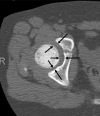
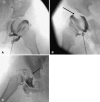
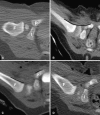
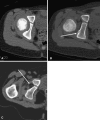
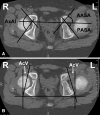


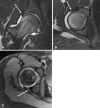
References
-
- {'text': '', 'ref_index': 1, 'ids': [{'type': 'DOI', 'value': '10.1302/0301-620X.87B9.15928', 'is_inner': False, 'url': 'https://doi.org/10.1302/0301-620x.87b9.15928'}, {'type': 'PubMed', 'value': '16129740', 'is_inner': True, 'url': 'https://pubmed.ncbi.nlm.nih.gov/16129740/'}]}
- Argenson JN, Ryembault E, Fletcher X, Brassart N, Parratte S, Aubaniac JM. Three-dimensional anatomy of the hip in osteoarthritis after developmental dysplasia. J Bone Joint Surg Br. 2005;87:1192–1196. - PubMed
-
- None
- Bowen JR, Kotzias-Neto A. Developmental Dysplasia of the Hip. Brooklandville MD. Data Trace Publishing Co 2006;31–32:70–77.
-
- None
- Bowen JR, Kruse R. Complications in the treatment of developmental dysplasia of the hip. In: Epps CH Jr, Bowen JR, eds. Complications in Pediatric Orthopaedic Surgery, 3rd ed. Philadelphia, PA: JB Lippincott; 1994.
-
- {'text': '', 'ref_index': 1, 'ids': [{'type': 'PubMed', 'value': '2644290', 'is_inner': True, 'url': 'https://pubmed.ncbi.nlm.nih.gov/2644290/'}]}
- Clarke NM, Clegg J, Al-Chalabi AN. Ultrasound screening of hips at risk for CDH. Failure to reduce the incidence of late cases. J Bone Joint Surg Br. 1989;71:9–12. - PubMed
-
- {'text': '', 'ref_index': 1, 'ids': [{'type': 'DOI', 'value': '10.1097/01.blo.0000193511.91643.2a', 'is_inner': False, 'url': 'https://doi.org/10.1097/01.blo.0000193511.91643.2a'}, {'type': 'PubMed', 'value': '16331000', 'is_inner': True, 'url': 'https://pubmed.ncbi.nlm.nih.gov/16331000/'}]}
- Clohisy MD, Keeney JA, Schoenecker PL. Preliminary assessment and treatment guidelines for hip disorders in young adults. Clin Orthop Relat Res. 2005;441:163–179. - PubMed
Publication types
MeSH terms
LinkOut - more resources
Full Text Sources
Medical
Research Materials

